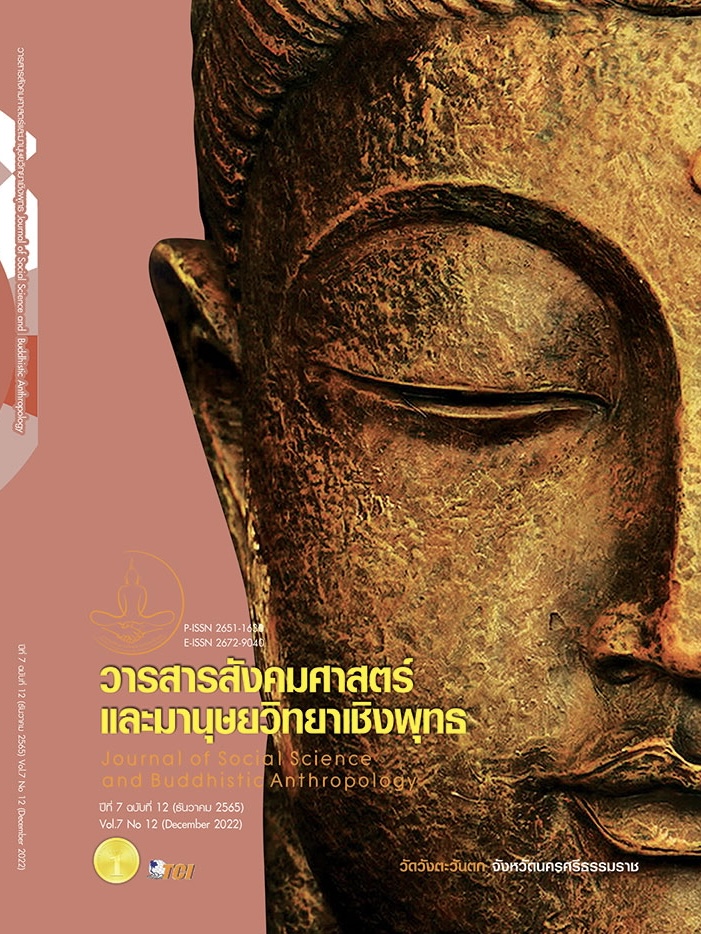THE DEVELOPMENT OF DIGITAL MEDIA AND PRECISE APPLICATION FOR LEARNING AND EXPLORING THE INFORMATION OF THE RELIGIOUS TOURISM AND MEDITATION SITES IN THE SECONDARY CITIES IN THE UPPER NORTHERN THAILAND
Keywords:
Digital Media Innovation, Accurate Application, Religious and Meditation Tourist Attractions, The Secondary Cities in The Upper NorthernAbstract
The objectives of this research were to 1) explore and collect information about tourist attractions in religious and meditation retreats, and 2) develop innovative digital media and precise applications for learning and exploring tourist attractions at the secondary cities in the upper northern. The research design was a qualitative research. The sampling group included general tourist and the target groups who are selectively scholar monks, qualified local experts and elderlys. The data collections tools were in-depth interviews and group discussions. The research had presented by expository and descriptive method. Therefore, the results of the research revealed that 1) religious and meditation retreats tourist attractions in the upper northern part of the secondary city tourism area were consisted of a tourist attraction, cultural attraction, intellectual tourist attraction and tourist meditation retreats. Most of the important things inside the temples were an ubosot, a viharn, a chedi (the Buddha’s relic ), an art gallery or a museum, the principal Buddha image, Phra That (Stupa), Phra Chao Thanjai, a bell tower, a replica of the Buddha's footprint, a doorway, murals or wall paintings and viewpoints of the temple. The distinctive identities were the temple’s architecture, Buddhist sculptures and paintings with the application of a blend of Buddhist art in Lanna and Burmese including Tai Yai and Tai Lue arts. Those identities were incorporating Buddhist ethics and beliefs which reflect the prosperity of Buddhism in the past as well, then 2) to develop innovative digital media of tourist attractions at the secondary cities in the upper northern, comprise e-books and online videos. The innovative digital media of tourist attractions communicated to tourists via Buddhist Tourism, YouTube channel, Google Sites and AnyFlip website. The particular application for learning and discovering tourist attractions met the needs of tourism users which presented on smartphones and tablet devices.
References
จุฑาพร บุญคีรีรัฐ. (2563). การเปลี่ยนแปลงรูปแบบการท่องเที่ยวกับเทคโนโลยีสารสนเทศบนโลกดิจิทัล. วารสารปัญญาภิวัฒน์, 12(2), 285-298.
นฤพนธ์ เพ็ชรพุ่ม และคณะ. (2560). การพัฒนาเว็บแอปพลิเคชันเพื่อการท่องเที่ยวประเทศไทย. ใน รายงานการวิจัย. กรุงเทพมหานคร: มหาวิทยาลัยเทคโนโลยีพระจอมเกล้าพระ นครเหนือ.
ภัชรบถ ฤทธิ์เต็ม. (2558). รูปแบบการจัดการท่องเที่ยวเชิงศาสนาและวัฒนธรรมในวัด. วารสารศิลปศาสตร์มหาวิทยาลัยอุบลราชธานี, 11(1), 1-21.
วิทยาลัยการจัดการ. (2561). สื่อสารโดนใจ รุ่นใหญ่วัยสีเงิน. กรุงเทพมหานคร: มหาวิทยาลัยมหิดล.
สถาพร เกียรติพิริยะ. (2563). การส่งเสริมการท่องเที่ยวเมืองรองด้วยเทคโนโลยีสื่อดิจิทัล. วารสารมหาจุฬานาครทรรศน์, 7(12), 436-448.
สำนักงานสถิติแห่งชาติ. (2561). การมีการใช้คอมพิวเตอร์ อินเทอร์เน็ต โทรศัพท์มือถือ. เรียกใช้เมื่อ 1 มีนาคม 2564 จาก http://service.nso.go.th/nso/web/ statseries/statseries22.html
สำนักส่งเสริมและพัฒนาสุขภาพจิต. (2560). คู่มือความสุข 5 มิติสำหรับผู้สูงอายุ. นนทบุรี: โรงพิมพ์ ชุมนุมสหกรณ์การเกษตรแห่งประเทศไทย จำกัด.
สุกัลยา โหราเรือง. (2563). การศึกษาวิเคราะห์กิจกรรมการท่องเที่ยวเชิงพุทธในล้านนา. วารสารสังคมศาสตร์ และมานุษยวิทยาเชิงพุทธ, 5(3), 70-85.
สุทธยา สมสุข. (2563). พฤติกรรมการใช้สื่อสังคมออนไลน์ของผู้สูงอายุ. วารสารปาริชาตมหาวิทยาลัยทักษิณ, 33(1), 63-76.
Chansiriwat, T. et al. . (2016). Factors influencing website accessibility of the elderly. Journal of Industrial Technology Ubon Ratchathani Rajabhat University, 6(2), 66-181.
Downloads
Published
How to Cite
Issue
Section
License
Copyright (c) 2022 Journal of Social Science and Buddhistic Anthropology

This work is licensed under a Creative Commons Attribution-NonCommercial-NoDerivatives 4.0 International License.








